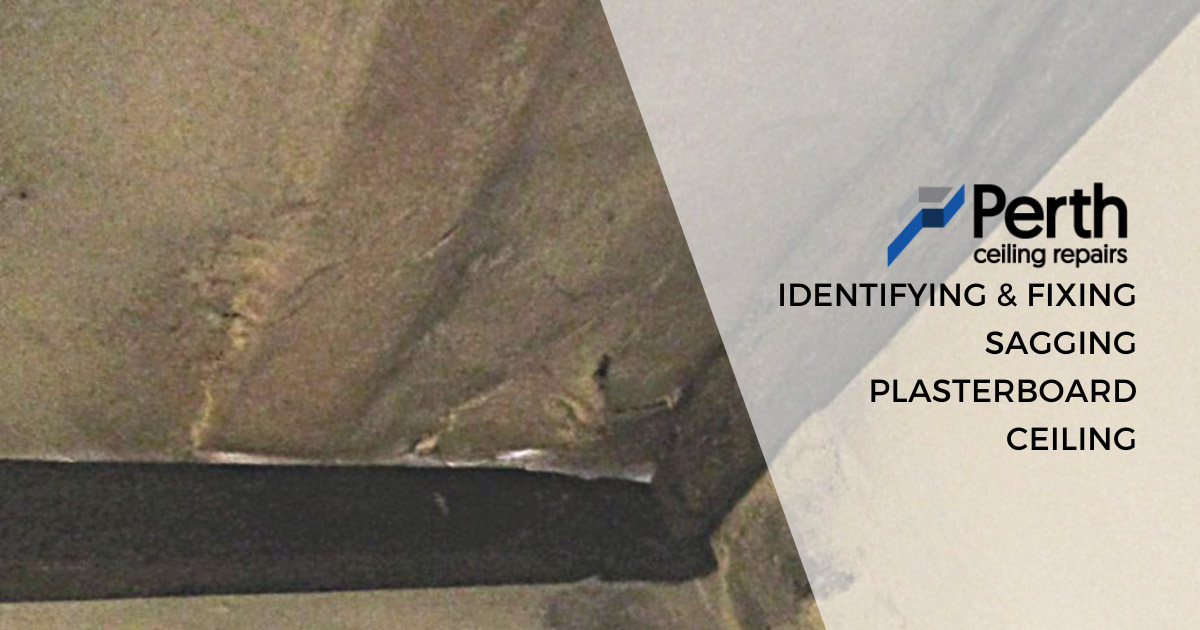
Perth Ceiling Repairs know the risk of leaving a sagging plasterboard ceiling untouched. When left unchanged the ceiling can collapse, posing a risk to others. Furthermore, water damage can spread quickly, resulting in a costly repair exercise. However, figuring out the cause of a sagging plasterboard ceiling and engaging a company like Perth Ceiling Repairs will ensure the most cost-effective solution to your problem. We have included the top 4 reasons for a sagging ceiling and the signs you should look out for.
Causes of Plasterboard Ceiling Sagging
A sagging plasterboard ceiling is not only an eyesore, but it can also be potentially dangerous. One of the worst things to do is ignore a sagging ceiling because it can lead to more expensive repairs, such as when water or other substances gets trapped in the ceiling. These damages can be avoided if you take care of any sagging ceilings before they get worse.
1. Foundation and Structural Movement
The idea of a building that can change with the temperature is not new. The movement of structures and foundations can create problems, but these are not insurmountable. When movement occurs due to temperature changes or poor foundations, your ceiling can stretch, warp, crack and even sag.
2. Water Leaks From the Roof
Have you got a build-up of mould or water staining? At times the cause for a sagging plasterboard ceiling can be due to damaged roofing that’s allowed water to enter into the insulation, and onto your ceiling. Signs of water leaks can be found by inspecting the roof and looking for areas water may have entered.
3. Burst Pipe
If you have water damage in your plasterboard ceiling and there is no damage to the roof, the likely cause in this instance could be a burst pipe or a leaking drain from an upstairs bathroom, for example. To tell if this is the root cause, turning off your home’s water will show if the water damage has stopped extending.
4. Termites
It is with very good reason that homeowners panic at the sight of termites. Termites will eat through almost any timber. When termites eat away at timber it causes the timber structure to become weak, resulting in ceiling cracks and sagging. If you see any white ants, termites, or timber that’s been decimated, the likely cause is termites and should be inspected by a professional in the first instance to mitigate extensive damage.
5. Age
The age of the ceiling and the building itself are often the main reasons for cracking or sagging. As buildings age, so do the fasteners and adhesives that hold them together. When these start to fail, you may see the building’s structure and ceiling shift, including cracks around cornices or sagging near attached drywall.
Even relatively new homes can suddenly have spider cracks in their cornices and ceilings. When your new home is “in” for the first two to three years after completion, any moisture in the materials or adhesives will evaporate. As your cornices, ceilings and walls are held in place, cracks can appear.
6. Vibrations From Roller Doors
Garage ceilings may experience more frequent vibrations than other areas of your property. Motorised roller shutters and panel lift doors installed in buildings can create sharp, repetitive movements that are transmitted to the ceiling. If these vibrations are repeated often enough, the constant stress can cause the garage ceiling to crack, warp, or sag.
This can cause serious problems when doors or windows become misaligned due to ceiling movement. It is often difficult to tell whether ceiling cracks caused by these vibrations are structural or cosmetic damage.

What Are the Signs of a Collapsed Plasterboard Ceiling?
Many people are unaware of the warning signs of a collapsed plasterboard ceiling. The following are some of the warning signs that you should look for:
- The plasterboard ceiling is damaged and has fallen off.
- You can see cracks in the ceiling with water leaks or mould on the surface.
- The plasterboard is beginning to sag and you can hear a creaking sound.
- You start to hear a cracking sound and if you look up, you see cracks in the corners.
It’s essential to repair plaster ceilings when you notice the first signs of sagging or cracks to ensure the best resolution.
Sagging Plasterboard Ceiling Repair
If you are looking for the best ceiling repairs in Perth, look no further! Perth Ceiling Repairs are licensed professionals who will come and inspect your sagging plasterboard ceiling before giving you a quote for the work to be done. We guarantee that we have the expertise to provide you with a cost-effective solution for repairing your roof’s sagging plasterboard ceiling, using modern techniques and materials.
Ceiling repair options:
- Simple repairs
- Cover-up job
- Total ceiling replacement
- Major repairs
We’ve seen it all and fixed nearly all. So don’t hesitate and come to us for any of your ceiling needs – we’ll have your ceiling looking as good as new in no time!

